Lean Portfolio Management
Most strategy dialogues end up with executives talking at cross-purposes because … nobody knows exactly what is meant by vision and strategy, and no two people ever quite agree on which topics belong where. That is why, when you ask members of an executive team to describe and explain the corporate strategy, you frequently get wildly different answers. We just don’t have a good business discipline for converging on issues this abstract.
—Geoffrey Moore, Escape Velocity
Talk to Learning Advisor
Lean Portfolio Management
The Lean Portfolio Management (LPM) competency aligns strategy and execution by applying Lean and systems thinking approaches to strategy and investment funding, Agile portfolio operations, and governance.
LPM provides an alignment and governance model for a specific SAFe Portfolio, which contains a set of Development Value Streams (DVS) for a business domain in an Enterprise. Each DVS builds, supports, and maintains Solutions delivered to the Customer, whether internal or external to the enterprise. Examples include developing an e-commerce website, medical device, or satellite and developing and deploying a software application within an enterprise for internal customers.
LPM is one of the seven core competencies essential to achieving Business Agility. Each core competency is supported by a self-assessment, enabling the enterprise to assess its proficiency. The Measure and Grow article provides a competency assessment and recommends improvement opportunities for implementing LPM.
Lean Portfolio Management Courses
Search:
| Event | Venue | Date | |
|---|---|---|---|
| SAFe® Lean Portfolio Management 6.0 (LPM) Certification – Remote Class(Central Standard Time Zone)– April 25-26, 2024 |
|
Register | |
| SAFe® Lean Portfolio Management 6.0 (LPM) Certification – Remote Class(Central Standard Time Zone)– May 23-24, 2024 |
|
Register | |
| SAFe® Lean Portfolio Management 6.0 (LPM) Certification – Remote Class(Central Standard Time Zone)– June 20-21, 2024 |
|
Register | |
Lean Portfolio Management
The Lean Portfolio Management (LPM) competency aligns strategy and execution by applying Lean and systems thinking approaches to strategy and investment funding, Agile portfolio operations, and governance.
LPM provides an alignment and governance model for a specific SAFe Portfolio, which contains a set of Development Value Streams (DVS) for a business domain in an Enterprise. Each DVS builds, supports, and maintains Solutions delivered to the Customer, whether internal or external to the enterprise. Examples include developing an e-commerce website, medical device, or satellite and developing and deploying a software application within an enterprise for internal customers.
LPM is one of the seven core competencies essential to achieving Business Agility. Each core competency is supported by a self-assessment, enabling the enterprise to assess its proficiency. The Measure and Grow article provides a competency assessment and recommends improvement opportunities for implementing LPM.
Why Lean Portfolio Management?
Traditional approaches to portfolio management were not designed to compete in the ‘age of software and digital.’ Enterprises face a higher degree of uncertainty and need to deliver innovative solutions faster. Many legacy portfolio practices remain despite massive market changes and how businesses operate in the digital era.
Modernizing portfolio management is critical to supporting SAFe’s Lean-Agile way of working and competing in this new reality. Fortunately, many enterprises have already traveled this path, and the change patterns are apparent, as shown in Figure 1.

LPM has the highest decision-making and financial accountability for the solutions and development value streams in a SAFe portfolio. The people who fulfill the LPM function have various roles and titles and often reside in different parts of the organization’s hierarchy. Because LPM is vital to the enterprise, executives and business owners who understand the financial, technical, and business contexts hold strategy and investment funding responsibilities. They are accountable for the overall business outcomes and addressing the challenge of defining, communicating, and aligning strategy with execution.
Figure 2 illustrates the three dimensions of LPM, followed by a brief description and a set of roles needed for its responsibilities.
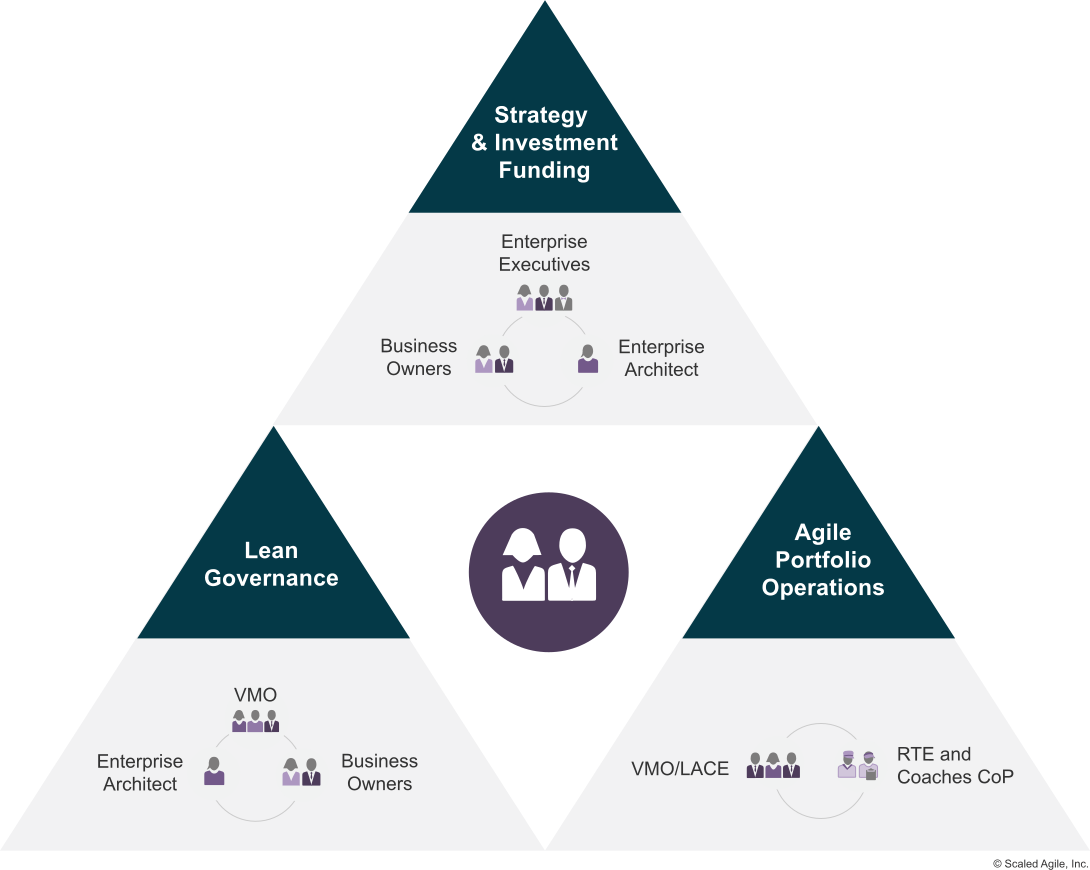
- Strategy & Investment Funding ensures the entire portfolio is aligned and funded to create and maintain the solutions needed to meet business targets.
- Agile Portfolio Operations coordinates and supports decentralized ART execution and fosters operational excellence.
- Lean Governance supports oversight of spending, audit, compliance, expenditure, measurement, and reporting.
The following sections describe these dimensions.
Strategy and Investment Funding
Strategy and investment funding ensures that the entire portfolio is aligned and funded to create and maintain the solutions needed to meet business targets. An enterprise can only accomplish its ultimate business objectives by allocating the ‘right investments’ to building the ‘right things.’
However, portfolio strategy is much more than prioritization and selecting the best investments. The portfolio needs to understand its role in achieving the enterprise strategy. Therefore, LPM should understand the portfolio’s current state, develop a plan to evolve to a better, differentiated future state, and continuously adjust the vision and plan to address the changing business context.
Some changes will require large initiatives to achieve the future state. LPM and its stakeholders need to create business and enabler Epics that feed directly into the Portfolio Backlog.
The strategy and investment funding responsibilities (Figure 3) require collaborations among enterprise executives, Business Owners, and Enterprise Architects, including portfolio stakeholders and other technologists. Each responsibility is described in the sections that follow.
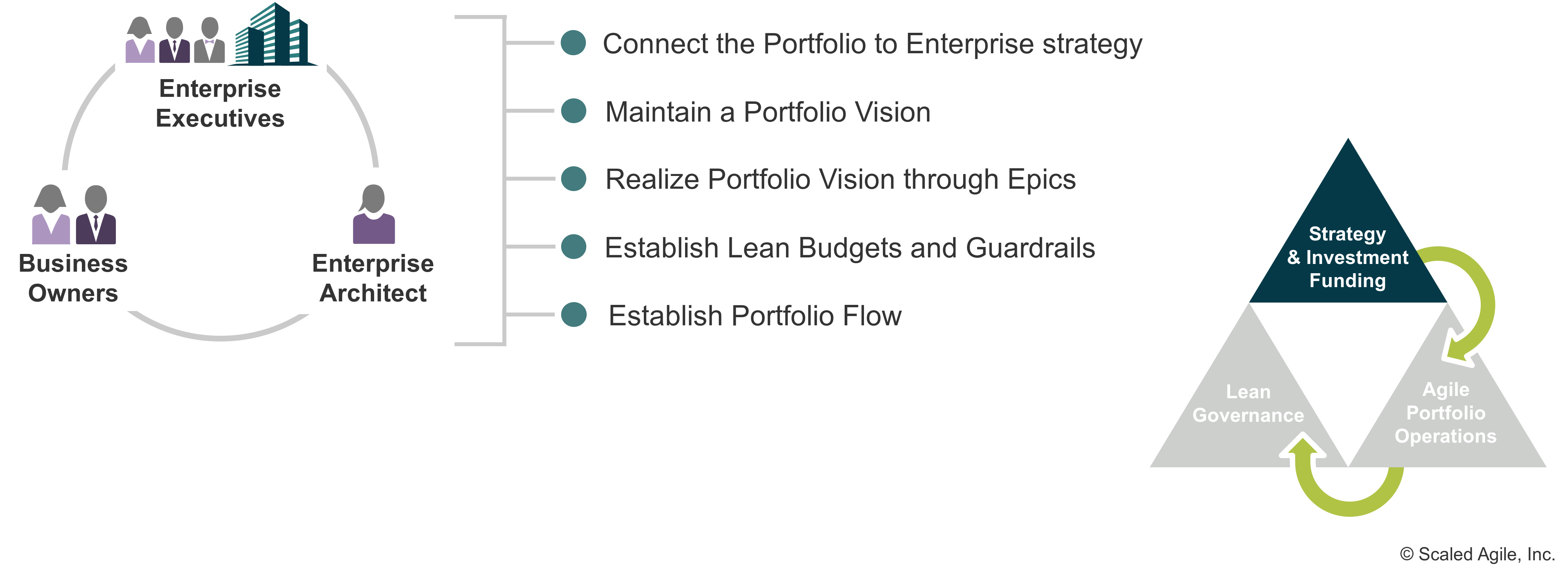
Connect the Portfolio to the Enterprise Strategy
The portfolio strategy should support the enterprise’s broader business objectives. That’s why connecting the portfolio to the enterprise strategy is the primary responsibility of the strategy and investment funding collaboration.
Moreover, linking the portfolio to the organization’s strategy is bi-directional. The portfolio connects to the enterprise business strategy through Strategic Themes and the portfolio budget. It provides feedback to the enterprise via the portfolio context (described in the Enterprise article).
Maintain a Portfolio Vision
Portfolio Vision
The Portfolio Vision describes the future state of its development value streams and solutions. The current and future state difference represents the gap that LPM translates into the vision.
Effective collaboration across the portfolio requires the continuous communication of the portfolio vision, goals, ideas, and expectations openly and transparently. Business Owners should frequently communicate the vision and the strategic themes, for example, during PI planning, all-hands company meetings, and throughout the PI.
Gaining portfolio alignment requires people to work toward a shared goal and purpose beyond any individual, team, ART, or value stream. This ‘one portfolio’ mindset is critical to achieving success toward the strategic themes and having the agility to make mid-course corrections fluently. The quote below reminds us that the purpose of alignment is not about centralized control.
The more alignment you have, the more autonomy you can grant—Stephen Bungay, author and strategy consultant
Instead, alignment provides a powerful way to turn the portfolio vision into an executable strategy. Indeed, this goes well beyond the words in a slide deck. It unleashes all portfolio members’ creative and productive energy toward achieving its goals and further unlocks people’s intrinsic motivation. Developing the vision and strategy can be difficult and time-consuming. However, this work is not a once-and-done exercise. As new information is learned about the solution set, including customer feedback and Key Performance Indicators (KPIs), the LPM function periodically reviews the portfolio canvas (e.g., quarterly). They explore scenarios where the portfolio could evolve to a better differentiated future state aligned with the strategic themes.
Enterprise Architecture
The road to a better future state should be paved with architectural principles and practices that enable the ongoing evolution of the portfolio’s solution set. This makes enterprise architecture a critical component of strategy and investment funding. Enterprise Architects help translate the business vision and strategy into effective technology plans. Enterprise Architects promote adaptive design and engineering practices to drive the portfolio’s architectural initiatives. Enterprise Architects also facilitate the reuse of hardware and software components and proven design patterns across the portfolio to help value streams develop and enhance solutions faster and with higher quality.
Organizations must respond simultaneously to new business challenges and implement larger-scale architectural initiatives requiring intentionality and planning. Emergent design alone is not sufficient at scale. Enterprise Architects help improve results by offering architectural governance and fostering the right balance between intentional and emergent design. Achieving this balance is essential to maintaining a healthy Architectural Runway across the portfolio and developing large-scale systems effectively. Therefore, Enterprise Architects may recommend technology standards and stacks for value stream level interoperability, APIs, hosting, and design methods for developing and testing cyber-physical systems.
Portfolio Roadmap
The best way to predict the portfolio’s future state is to create it through a purposeful and flexible portfolio roadmap (Figure 4). Because some portfolio initiatives may take years to develop and are safety critical (for example, aerospace, autonomous vehicles, and cyber-physical systems), a larger planning horizon beyond a few PIs may be required. The portfolio and solution roadmaps are bi-directional; each roadmap influences the other.
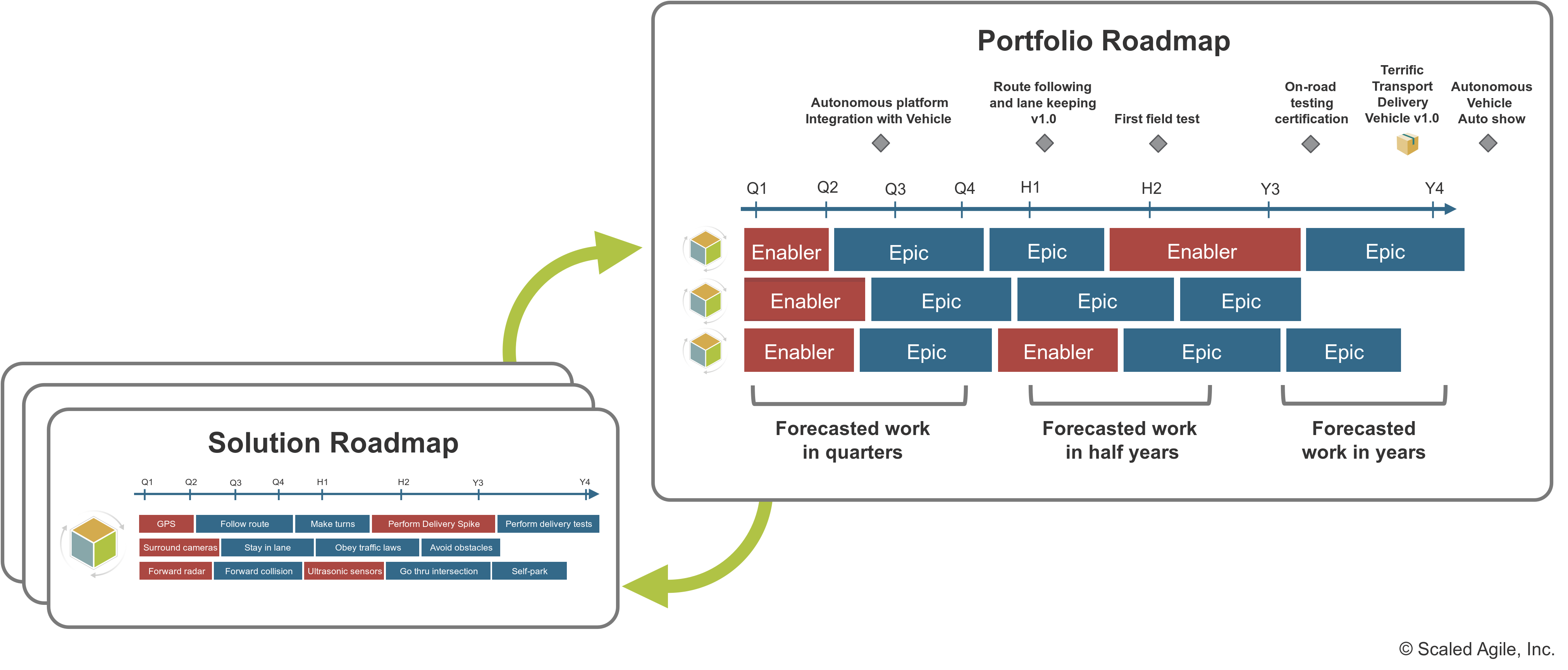
The portfolio roadmap integrates lower-level roadmaps into a more comprehensive view. The initiatives in the portfolio roadmap influence the direction and timing of the solution roadmaps, as Figure 4 illustrates.
Since the portfolio roadmap may span multiple years, estimating longer-term initiatives requires Agile methods. However, every enterprise should be cautious about such forecasts. While long-term predictability is a worthy goal, use flexible rolling-wave roadmaps to replace fixed plans. Lean-Agile Leaders should know that every long-term commitment decreases the organization’s agility.
Realize Portfolio Vision Through Epics
Many vision changes will require large initiatives (Epics) to achieve the future state. Business epics directly deliver business value, while Enabler epics advance the architectural runway to support upcoming business or technical needs. Since epics often have lots of uncertainty, it’s good practice to use the SAFe Lean Startup Cycle for their implementation.
Understanding the epics’ forecasted costs and gaining a high-level view of when the potential new value can be delivered is essential for comparing investments (see the portfolio roadmap described earlier). This forecast includes the MVP, proving or disproving the epic’s hypothesis and implementation if LPM makes a persevere decision. Sometimes overlooked, contractors and Suppliers should be part of the cost equation.
Establish Portfolio Flow
Portfolio business and enabler epics, capture, analyze, and approve new business and technology initiatives. These initiatives typically require the collaboration of multiple value streams or the creation of new value streams or ARTs.
In the context of strategy and investment funding, portfolio flow describes the process of managing portfolio epics through their lifecycle, including limiting the number of significant and typically cross-cutting initiatives in progress to match the portfolio’s capacity. LPM uses the portfolio Kanban system to visualize and restrict work-in-process (WIP), reduce batch sizes, and control the length of longer-term development queues. Successfully establishing portfolio flow requires knowing the total capacity for new development work versus ongoing maintenance and support activities. The enterprise can objectively evaluate and originate portfolio-level initiatives only when this balance is understood.
Another aspect of portfolio flow concerns operational excellence, which is the subject of the next section, Agile Portfolio Operations.
Agile Portfolio Operations
Agile portfolio operations coordinate and support decentralized ART execution and enable operational excellence. SAFe principles and the Lean-Agile mindset foster the decentralization of strategy execution to empower Agile Release Trains (ARTs) and Solution Trains.
The Agile portfolio operations collaboration and responsibilities (Figure 5) require the active engagement of the Value Management Office (VMO), Lean-Agile Center of Excellence (LACE), Release Train Engineer (RTE), and Scrum Master/Team Coach CoP. Figure 5. illustrates each of these responsibilities, followed by a description of each.
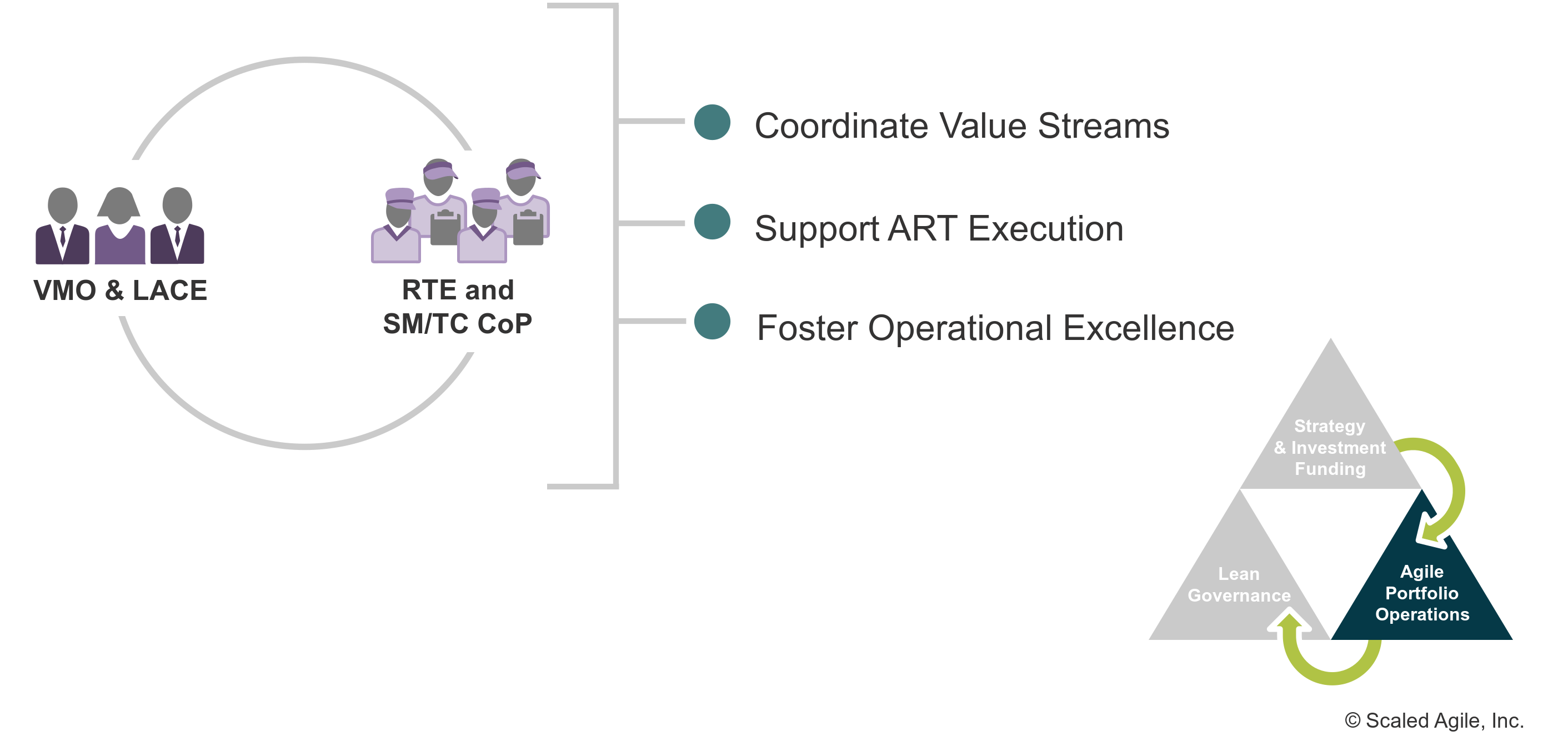
Coordinate Value Streams
Although many value streams operate independently, cooperation among solutions can provide unique, differentiating portfolio-level capabilities and benefits that competitors can’t match. Value Stream coordination defines how to manage dependencies and exploit the opportunities that exist only in the interconnections between value streams. To this end, Lean-Agile leaders understand their value streams’ challenges and opportunities. They make them as independent as possible while simultaneously interconnecting and coordinating them with the enterprise’s larger purpose.
Support ART Execution
The LPM function can help cultivate and apply successful ART execution patterns across the portfolio with the assistance of the Lean-Agile Center of Excellence (LACE). The LACE is often responsible for leading operational excellence with the help of an RTE and Scrum Master/Team Coach CoP. Together, they can optimize, address, and debug issues from Agile Teams, ARTs, and value streams. The LACE and CoPs provide a forum for sharing effective Agile ART execution, flow practices, and other knowledge. They become a continuous energy source to power the enterprise through the necessary organizational changes.
Foster Operational Excellence
Operational excellence focuses on continually improving efficiency, practices, and results to optimize business performance. LPM plays a leadership role in operational excellence, helping the organization achieve its business goals.
Value Stream Management
Value Stream Management (VSM) is a leadership and technical discipline that enables the maximum flow of business value through end-to-end solution delivery.
Lean thinking is the foundation of Value Stream Management. The lean principles provide a shared mindset for everyone involved in solution delivery to improve operational efficiency and eliminate delays. Although everyone in a SAFe portfolio plays a role in VSM, Lean Portfolio Management (LPM) is accountable for establishing the value streams and fostering operational excellence.
The Lean-Agile Center of Excellence (LACE)
Operating under the auspices of LPM, the LACE also plays a significant role in fostering operational excellence. This typically includes:
- Facilitating Value Stream identification workshops
- Communicating the business need for SAFe
- Integrating SAFe practices and fostering Communities of Practice
- Creating alignment around organizational changes
- Providing coaching and training to ART stakeholders,
- Solution Trains, and Agile Teams
- Establishing objective measures for progress, product, and process (see PI milestones in the Roadmap article)
From PMO to VMO
Many enterprises have discovered that centralized decision-making and traditional mindsets can undermine the move to Lean-Agile practices. As a result, some enterprises have abandoned the PMO approach, distributing all the responsibilities to ARTs and Solution Trains. Unfortunately, this choice can inhibit the adoption of successful execution patterns, standard measures, and reporting that can be developed and applied across the portfolio.
One option is redesigning the traditional PMO to become a Value Management Office (VMO). Operating through LPM, the VMO leverages the specialized skills, knowledge, and relationships of the current PMO while transitioning themselves and the portfolio to a new Lean-Agile way of working. VMO activities often include the following:
- Facilitates the portfolio events
- Works with the LACE to develop, harvest, and apply successful ART execution patterns across the portfolio
- Facilitates Lean budgeting and coordinates portfolio governance
- Fosters decentralized PI Planning and operational excellence
- Establishes objective metrics and reports progress toward business agility
- Focuses the portfolio on measuring and improving value delivery
- Leads the move to objective metrics, milestones, and Lean-Agile budgeting
- Establishes and maintains the systems and reporting capabilities
- Offer guidance for OKRs and KPIs
- Communicates and amplifies the portfolio’s strategy
- Fosters more Agile contracts and leaner Supplier and Customer partnerships
Accelerating Flow
While flow-based guidance is embedded throughput SAFe, a five-article series directly addresses impediments to flow: 1. Principle #6- Make value flow without interruptions, 2. Portfolio Flow, 3. Solution Train Flow, 4. ART Flow, and 5. Team Flow. These articles define flow with a set of ‘eight flow accelerators that foster operational excellence. The LACE can coach RTEs, and Scrum Masters/Team Coaches to address, optimize, and debug issues with achieving continuous flow. The VMO has a primary responsibility in improving portfolio flow.
Lean Governance
Lean governance is the function that supports oversight of spending, audit, compliance, expenditure, measurement, and reporting. The Lean governance collaboration and responsibilities (Figure 6) require the active engagement of the VMO, LACE, Business Owners, and Enterprise Architects. The following sections describe their duties.
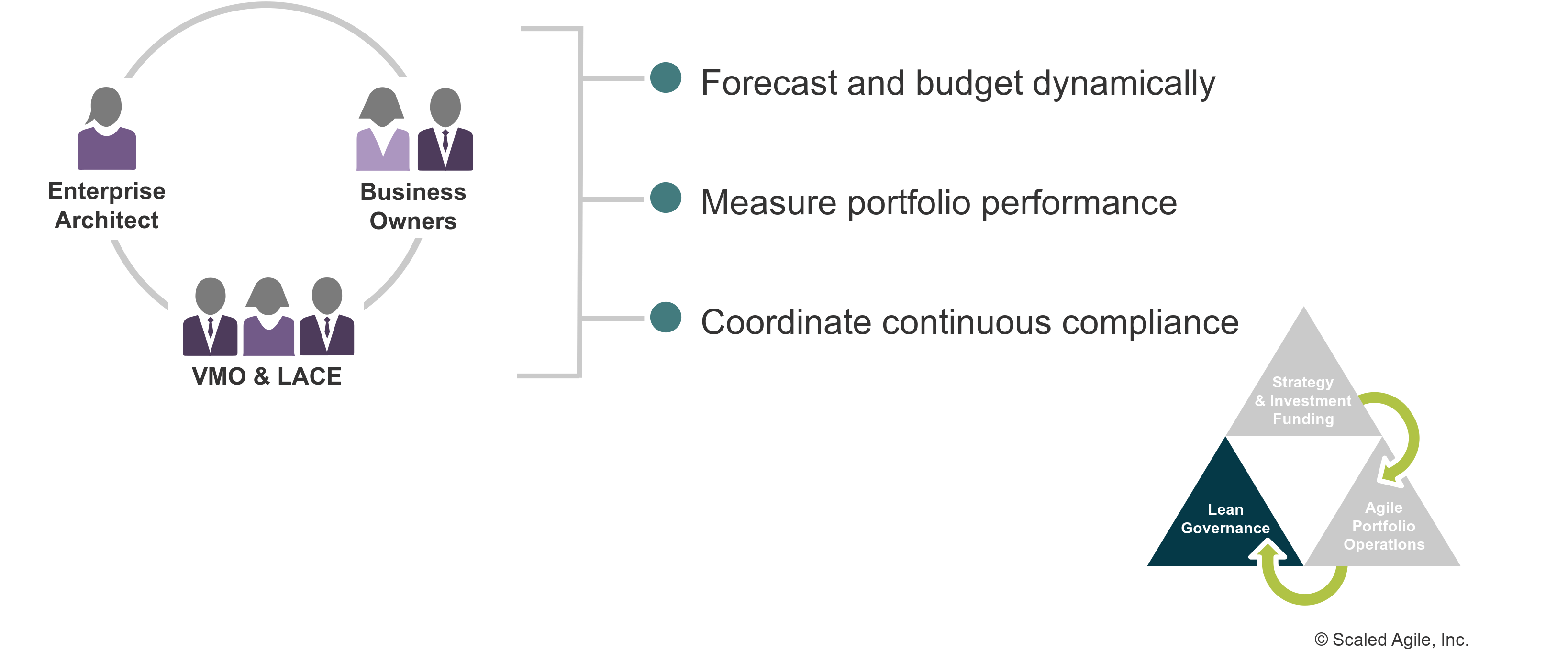
Forecast and Budget Dynamically
As described earlier, SAFe provides a Lean approach to budgeting—a lightweight, more fluid, Agile process that replaces the fixed, long-range budget cycles, financial commitments, and fixed-scope expectations of a traditional planning process. This new approach to planning and budgeting includes understanding the historical and forecasted future costs associated with each Solution and forecasted epics costs. LPM adjusts budgets on a cadence, typically every six months or when significant events warrant, as part of the strategic portfolio review or Participatory Budgeting events (see below).
Measure Portfolio Performance
Each portfolio establishes the minimum metrics needed to measure portfolio performance to ensure:
- Progress with strategy implementation
- Alignment of strategy and execution
- Spending aligns with the agreed boundaries
- Business outcomes are continually improving without too much oversight of feature implementation
- LPM competency is improving
Measure and Grow is how portfolios evaluate their progress toward business agility and determine their next improvement steps. It consists of the following three measurement domains:
- Outcomes: How well do the portfolio’s solutions meet customers’ needs and provide the expected results for the business?
- Flow: How efficient is the portfolio at delivering a continuous flow of value to its customers and the desired outcomes for the business?
- Competency: The LPM competency self-assessment enables organizations to evaluate their proficiency against the three dimensions of Strategy & Investment Funding, Agile Portfolio Operations, and Lean Governance.
The following sections describe these three domains.
Outcomes
A SAFe Portfolio primarily measures business outcomes by defining Objectives and Key Results (OKR) for Strategic Themes and Value Stream Key Performance Indicators (KPIs).
- OKRs are a goal-setting framework that provides objective evidence of progress (Key Results) toward achieving a set of business outcomes (objectives). They help anchor ambitious goals with reality. OKRs facilitate breaking out of status quo thinking and enable the portfolio to explore new, often unknown, territory. If the portfolio has a big dream—and inspiring strategic theme—OKRs will help measure progress toward achieving it.
- KPIs are specific and quantifiable measures of business results for the value streams within that portfolio. Outcome metrics of this kind are typically context-specific and depend heavily on the organization, business model, and the nature of solutions delivered to the customer. For example, the customer conversion rate may be a meaningful metric for an eCommerce business but would be inapplicable to a microchip manufacturer. Some indicators, however, may be successfully applied across contexts, such as the Net Promoter Score. The Value Stream KPIs article provides guidance for defining appropriate KPIs, informed by the strategic themes for that particular SAFe Portfolio.
Competency
Measuring the level of organizational competency for a SAFe portfolio is accomplished with the following assessments:
- SAFe Business Agility assessment is designed for business and portfolio stakeholders to assess their overall progress in achieving true business agility.
- LPM core competency assessment helps the LPM team and its stakeholders measure their proficiency against the three domains of Strategy and Investment Funding, Agile Portfolio Operations, and Lean Governance.
Each of these assessments follows a standard process pattern of running the self-assessment, analyzing the results, taking action, and celebrating the successes. See the ‘Measuring Competency’ section of the Measure and Grow article to download these assessments.
Coordinate Continuous Compliance
Lean audit and compliance provide continuous adherence while minimizing overhead and supporting the ongoing flow of value. This compliance may address internal or external financial auditing constraints and industry legal or regulatory guidelines. These obligations impose significant limits on solution development and operations. Traditional compliance procedures tend to defer these activities to the end of the project. That subjects the enterprise to the risk of late discovery, subsequent rework, and even compromising regulatory or legal exposure. Therefore, SAFe recommends a more continuous approach to coordinate ongoing compliance with relevant standards.
For more information, see the advanced topic article and whitepaper: Achieving Regulatory and Industry Standards Compliance with SAFe.
Assuring Big Data Security and Compliance
Every enterprise uses data to improve its products, optimize operations, and better understand its customers and markets. SAFe addresses’ big data’ concerns at the portfolio level as it requires vision, investment, and governance within and across the value streams within the portfolio. Big Data governance manages the availability, usability, integrity, and security of the data in enterprise systems based on internal data standards and policies controlling data usage. Effective data governance ensures that data is consistent and trustworthy and doesn’t get misused.[1]
Lean Portfolio Management Events
The effective operation of the LPM function relies on three significant events:
- Strategic Portfolio Review
- Portfolio Sync
- Participatory Budgeting
Typically, these events are held on a cadence, as illustrated in Figure 7.
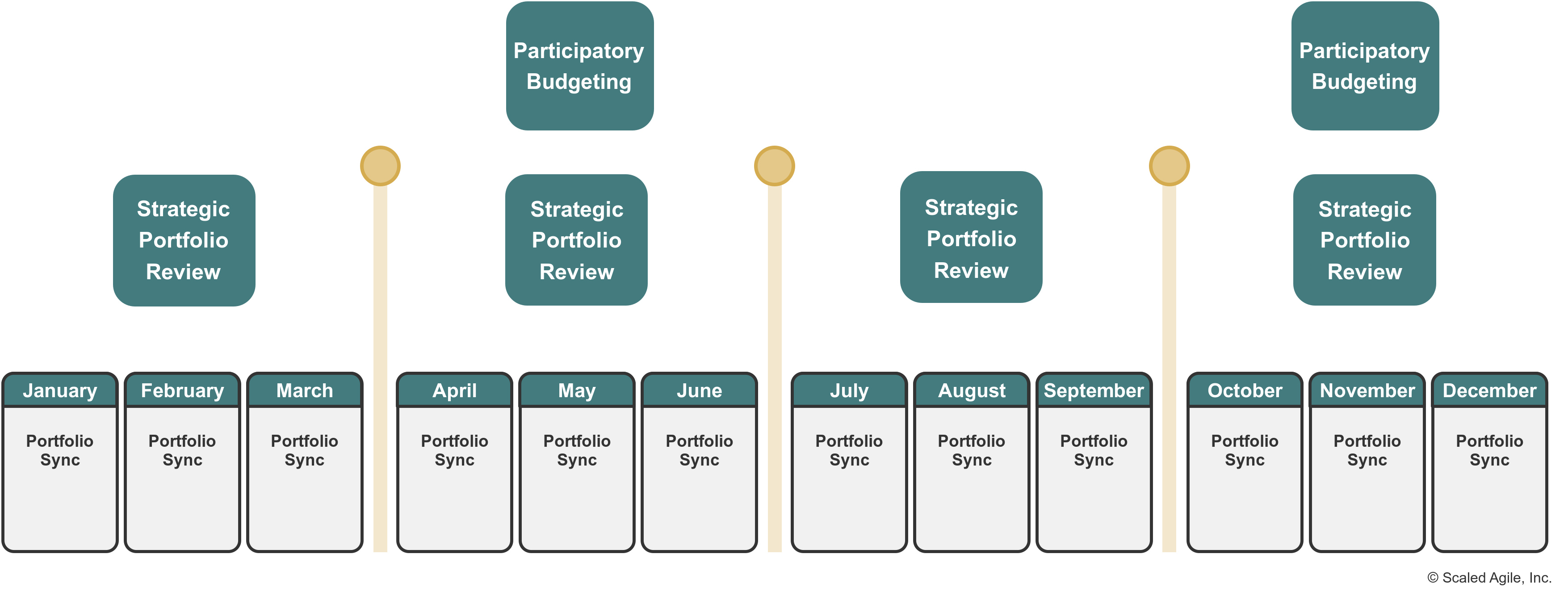
Strategic Portfolio Review
The strategic portfolio review event provides ongoing strategy, implementation, and budget alignment. This event focuses on achieving and advancing the portfolio vision. It’s typically held on a quarterly cadence, at least one month before the next PI Planning event, to enable value streams to prepare and respond to any changes,
Portfolio Sync
The portfolio sync provides visibility into how well the portfolio is progressing toward meeting its objectives. This event has a more operational focus than the strategic portfolio review. Topics typically include reviewing epic implementation, the status of KPIs, addressing dependencies, and removing impediments. The portfolio sync is generally held monthly and may be replaced with the strategic portfolio review on a given month.
Figure 8 compares the strategic portfolio review and portfolio sync events.
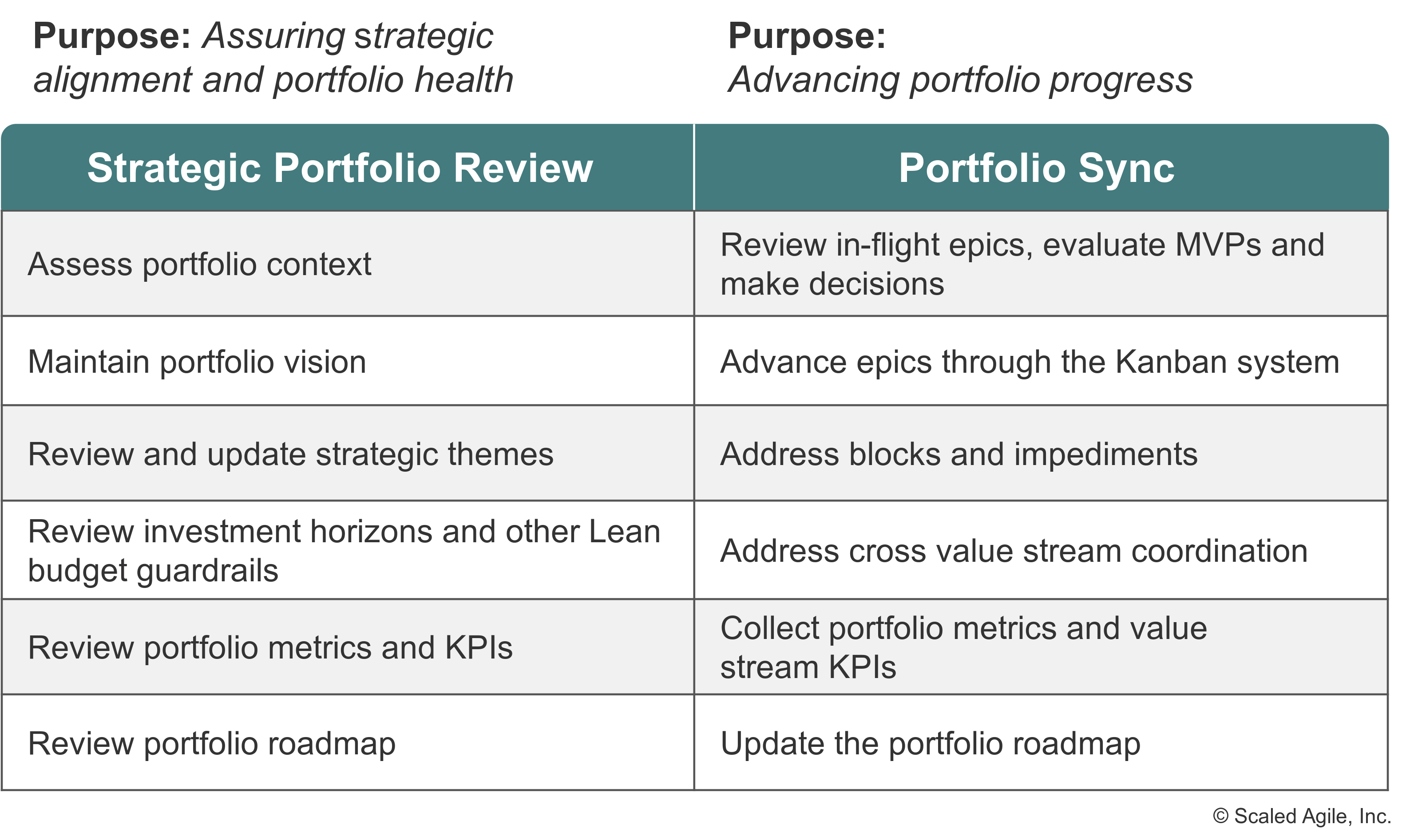
Participatory Budgeting
SAFe Participatory Budgeting (PB) is an LPM event in which a group of stakeholders decides how to invest the portfolio budget across solutions and epics. The resulting data is used to finalize adjustments to the value stream budgets. These budgets are typically adjusted twice annually using PB. If adjusted less frequently, spending is fixed for too long, limiting agility. Also, although more frequent budget changes may seem to support increased agility, they may create too much uncertainty and an inability to commit to any near-term course of action. (See Lean Budgets for more information).
Summary
Successfully defining and executing a strategy in a world of increasing uncertainty is challenging. It requires modernizing portfolio management, applying Lean-Agile thinking, and organizing Agile teams and ARTs around value streams that deliver a continuous flow of value to the enterprise’s customers.
Strategy and investment funding ensures the ‘right work’ is happening at the ‘right time.’ Continuous and early feedback on current initiatives, coupled with a Lean approach to funding, allows the portfolio to make the necessary adjustments to meet its business targets. Agile portfolio operations facilitate coordination across the portfolio’s value streams, maintaining alignment between strategy and execution and fostering continued operational excellence. Lean governance closes the loop by measuring portfolio performance and supporting dynamic budget adjustments to maximize value. Collectively, these competencies work together to create superior economic outcomes.
